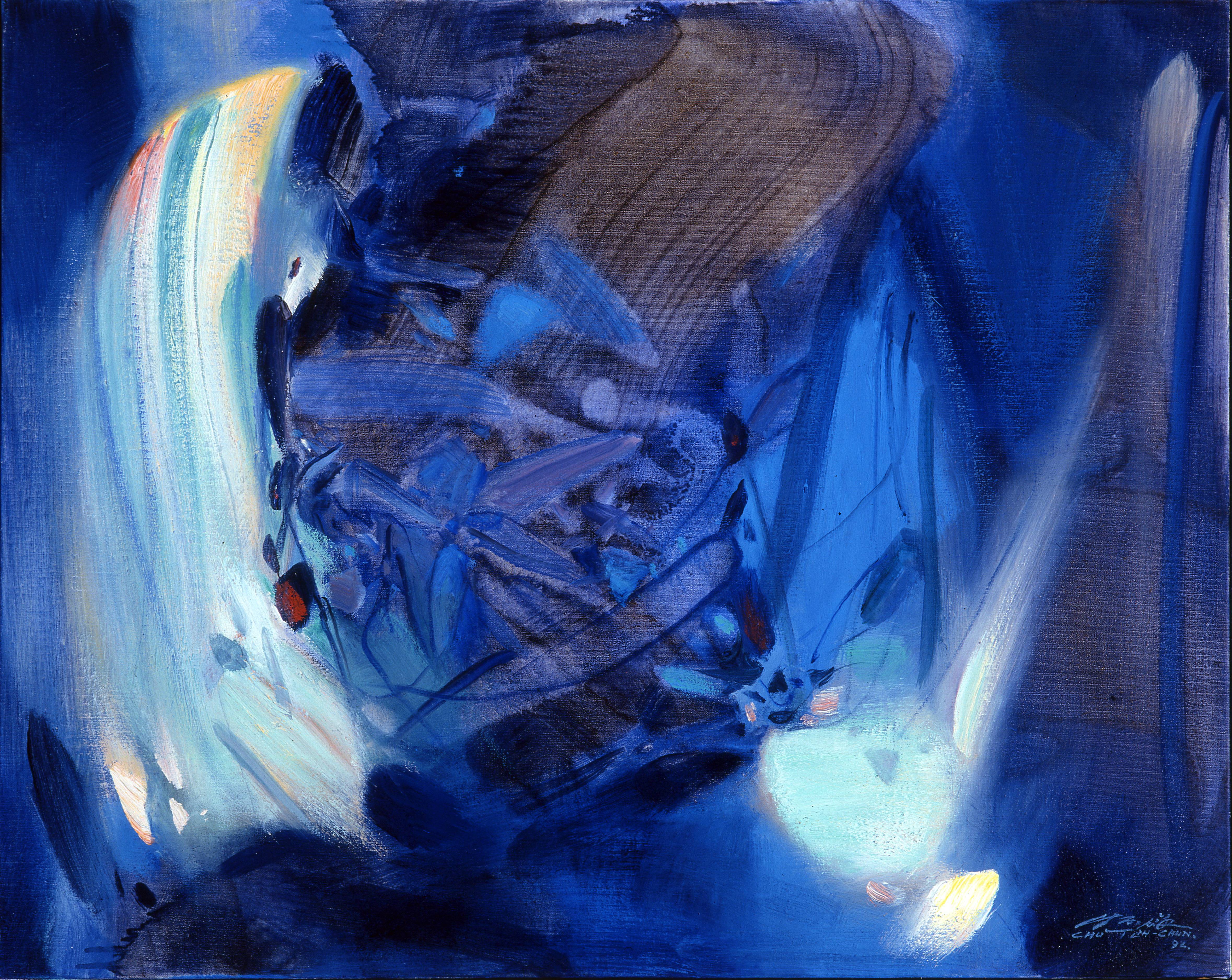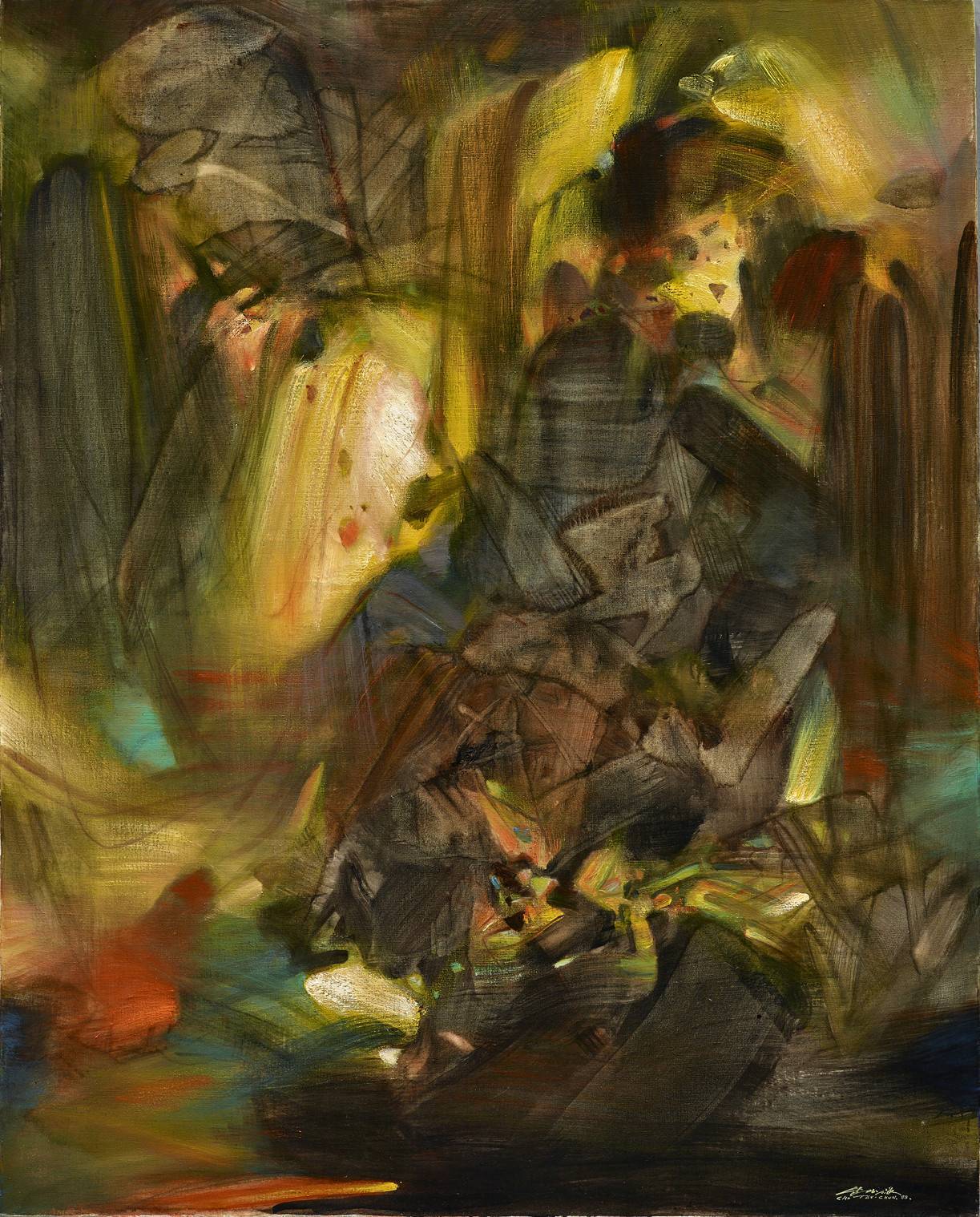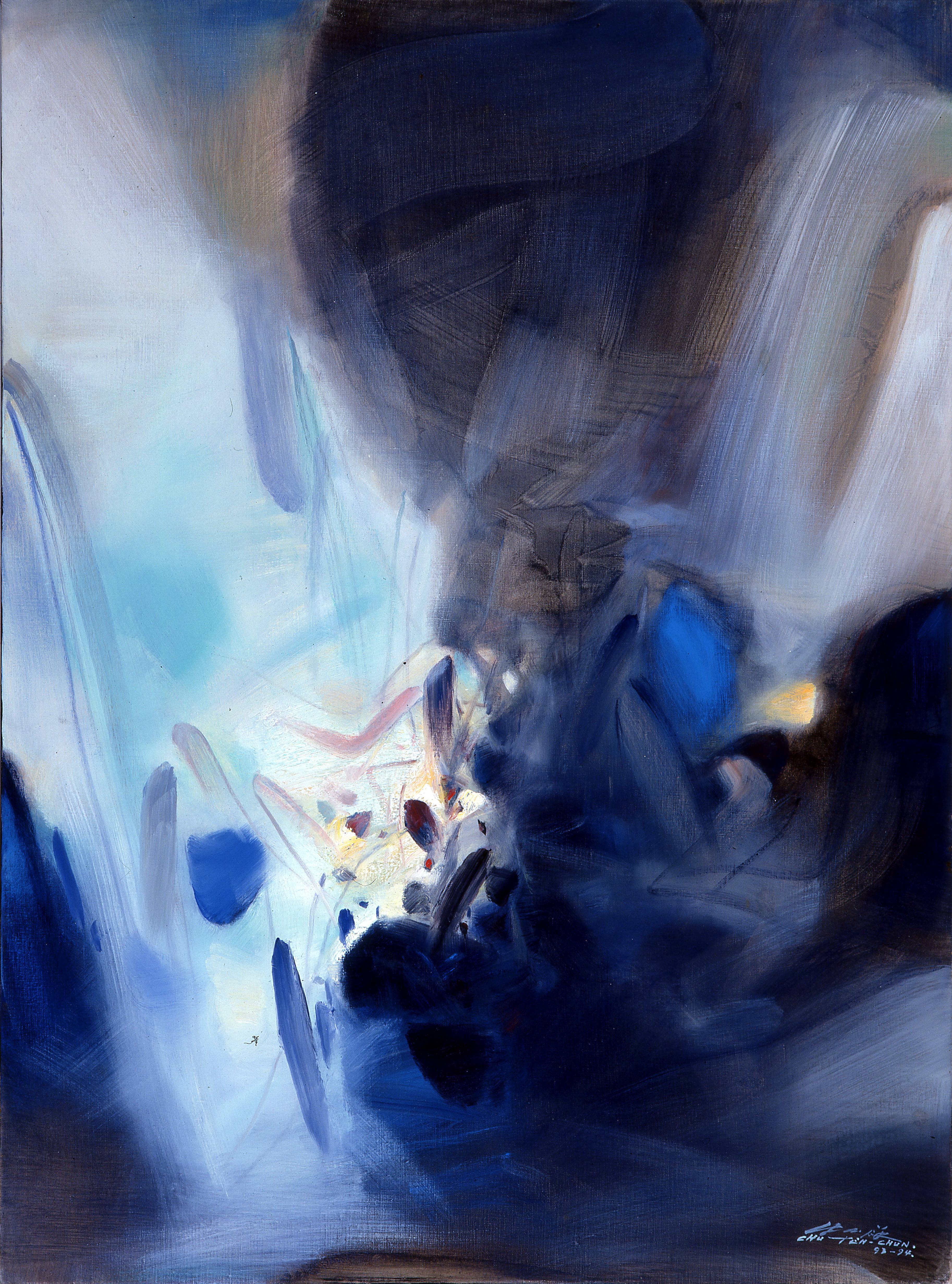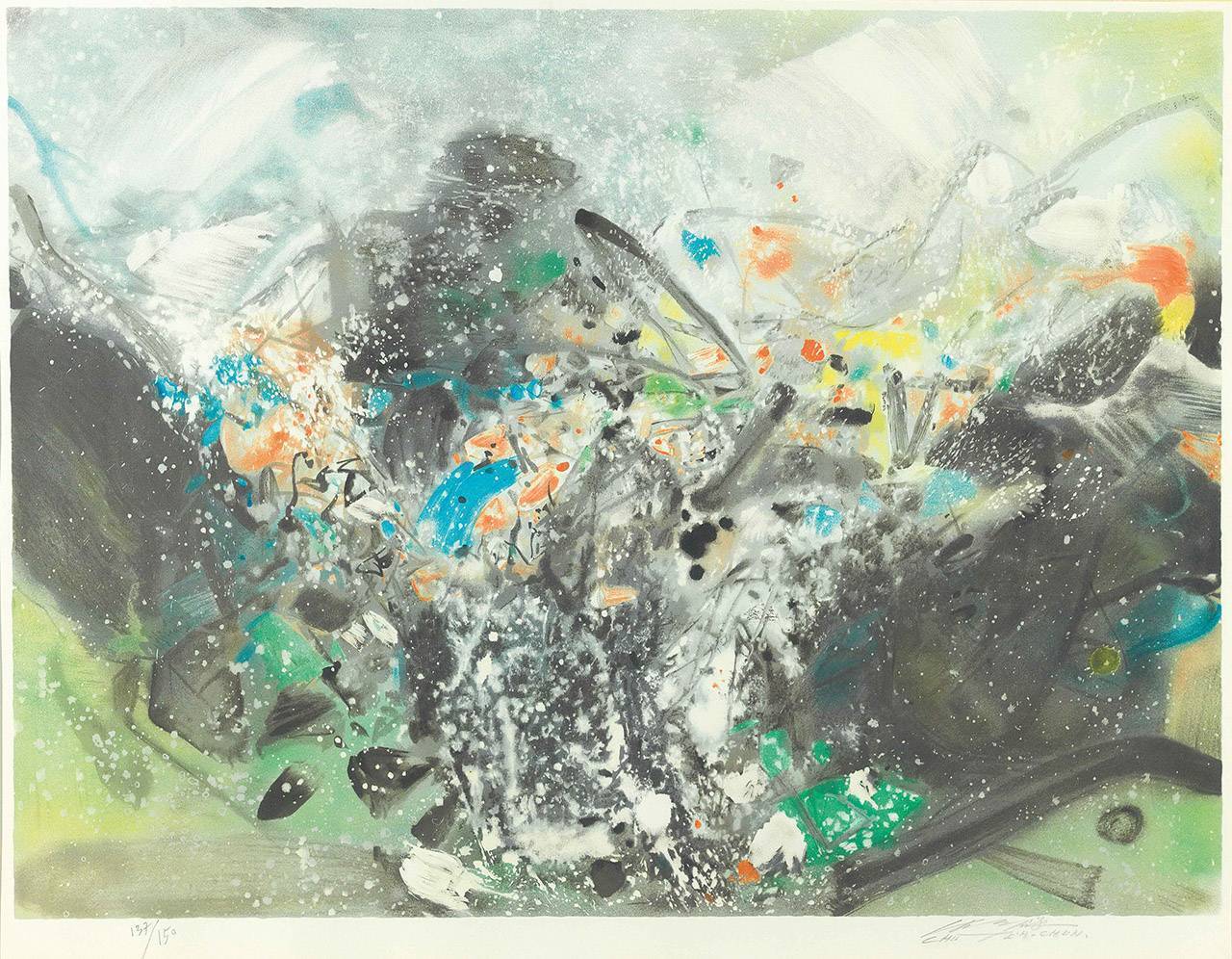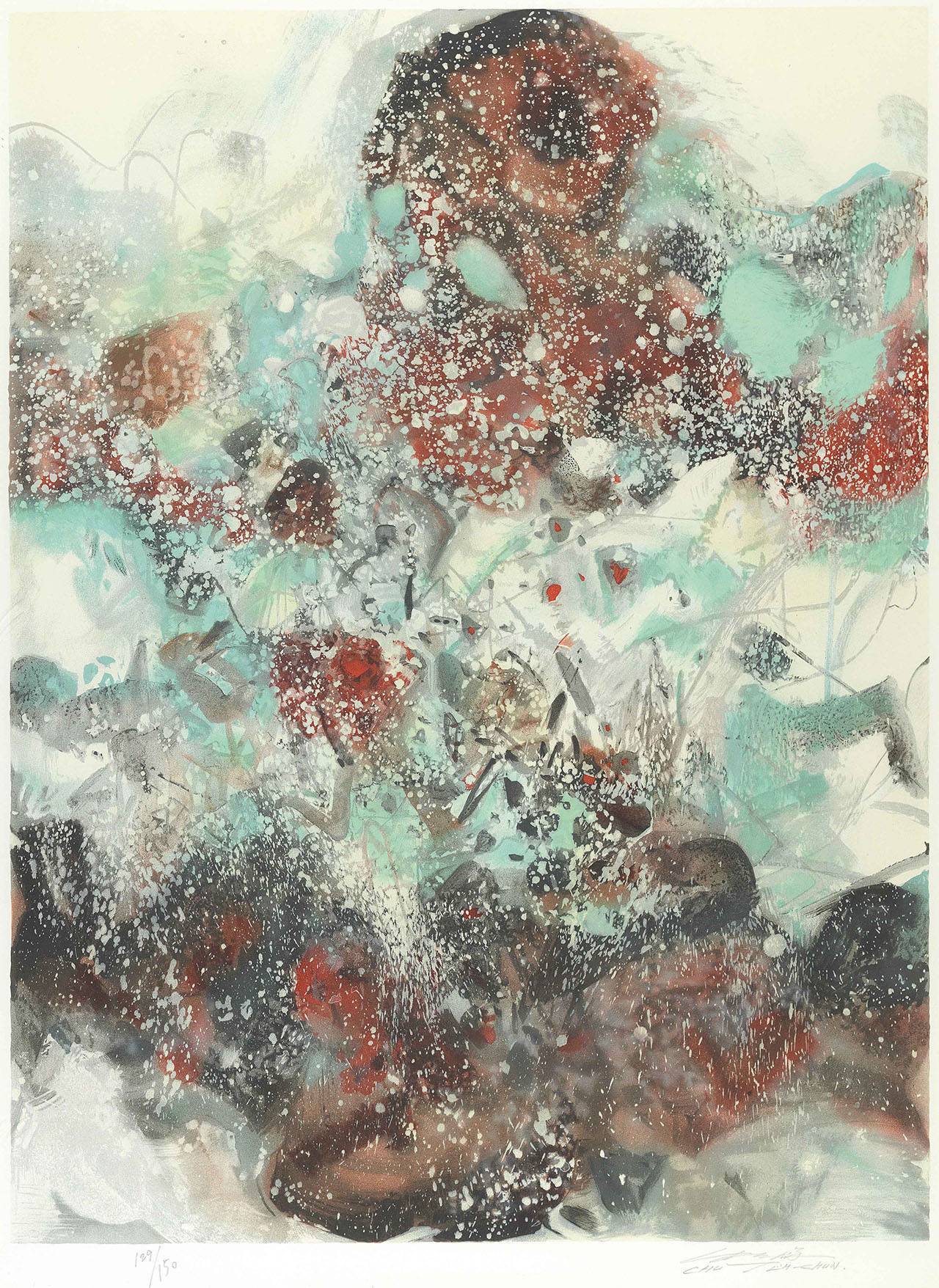InSian Gallery:【Regression and Change: Analysis of Chu Teh-Chun's Creation】
Foreword
After sixty years of painting career, talking about Zhu Dequn's articles is not enough to outline the whole picture of creation. His works show the process of oriental artists' relatives in European painting, from the acceptance of ideas to the transformation of forms, which specifically shows the results of long-term exploration of individuals in the Western environment. This paper attempts to interpret Zhu Dequn's creative content from the form of the work as an additional reference for artistic appreciation.
Comment on the form of creation
First, musicality and calligraphy imagery
Expressing music perception with painting vision is the expression orientation of Zhu Dequn's works. Exploring the creative background, the influence of Kandinsky (1866-1944) is obvious. Zhu Dequn once said: "Kantinsky created the abstract painting school. The concept comes from Cézanne's painting theory and begins with the expression of music form." Kandinsky published "The Art of Spiritual Harmony" in 1910. In the book, the creation comes from the "art of internal necessity", emphasizing the role of color and line in expressing the mind and the state of mind. This view predicts the development of abstract art in forty years. Kandinsky believes that among all art types, music has accurate scales and beats, and the melody that sounds can best show the harmony of the spirit, which is an ideal example of abstract art. Abstract art must learn from musical works and reflect the physical characteristics of music. Through constant experimentation, his paintings are reviewed by art history as works that are closest to music equivalents. This longing for musicality appears in Zhu Dequn's speeches and works, and becomes an ideal form of personal abstract painting. From the content of the painting, he can see his reverence for contemporary mainstream thoughts, continue to explore musical propositions with a loyal attitude, and maintain the theoretical basis of abstract art. In the pursuit of musicality, color and lines become the main visual content, and the conclusion of creative thinking is how to construct music images with their own methods. In terms of musical transmission characteristics, static colors and lines cannot show changes in melody; because of the lack of visual structure to support time, it cannot be interpreted by the naked eye. The only way is to show it through compositional rhythm or brushstroke. The compositional rhythm belongs to the color and shape problem, involving the combination of structure and space. The purpose is to extend the visual consciousness with graphic changes. The brushstrokes retain the traces of the body and tools, and evoke time memories with perceptual experience. Zhu Dequn adopted the brushstroke method to express the feeling of music in the form of abstract expression. In the picture, the brush marks of the brush are up and down, jumping and flying, full of emotions. He once said: "When I paint, some of them are impulsive impulses. As long as they face the canvas, the sensibility is full." Emphasizing the feeling of painting is exactly the same as music meditation. In fact, the brushwork of Zhu Dequn's automatic technique highlights the synchronization of technique and sound, and proves that his musical taste is conveyed through conceiving, but the heart of the scene is moved. Simply put, the brush is like a bow, like a baton, and plays his own views on the music. This dynamic brushstroke is closely related to Chinese calligraphy. More than once, he talked about his calligraphy experience and expressed his connection with personal techniques and Chinese calligraphy: "Why don't you bring the effect of ink painting into oil painting?" In the European art scene, the study of oriental calligraphy has its background. Tsachism, popular in Paris after the war, included artists such as Henri Michaux and Pierre Soulages, and tried to find the level of consciousness in automatic painting through calligraphy experience. Zhu Dequn and these creators share the same environment. In addition to making full use of calligraphy expertise, Chinese painters are bound to have a deeper understanding. In order to make the oil painting's movement obvious, the calligraphy art has the effect of “having pen and ink”. The pigment of the oil painting is diluted to accelerate the running of the brush on the one hand and the color rendering on the other hand. Calligraphy simultaneously shows the characteristics of time (writing process) and space (glyph structure), which is quoted by Zhu Dequn into abstract painting. As far as proposition research is concerned, Kandinsky's musicality and the temporality of calligraphy are combined to complete the concept of extradition, and Zhu Dequn's abstract form thus gains more room for expression. This style of abstract expression is not a result of the past, but a result of repeated experiments to integrate Western abstract theories and personal wishes. The concrete result is that the concept of musical expression is very oriental, close to the leisurely appearance of the Chinese Guqin, and it is far from the rigorous music of Western style. After a long exploration, Zhu Dequn searched for personal musical imagination from his own cultural roots and created his own abstract language. From the perspective of Western modern art, Kandinsky's rational thinking is transformed by the orientalism that the artist holds. The musicality of abstract painting appeals from the meticulous examination of ideas to the free taste of culture.
Second, the color in poetry and painting literature
In the process of textual research, Zhu Dequn's color comes from two different kinds of painting thinking. One is Cézanne's modern painting concept, and the other is the visual expression in Chinese poetry and painting. Cézanne believes that the harmony of form comes from feelings. Only the "present feeling" can fully interpret the styling, and color bears the greatest responsibility. "When the color is gorgeous, the form can be perfect." Such a proposal, Zhu Dequn is extremely fascinated. In his personal quotations, he repeatedly expressed his respect for Cézanne and constantly learned the connection between form and color from Cézanne's works. As far as the practice of color is concerned, Zhu Dequn's paintings do play the argument of “having a sense of the present” and express the color functions, including dark blue, orange red, grass green, geese, and purple, and fully sway the color in the picture. The bright colors on the screen break the color limitation of classical painting and form a romantic and open abstract style. Strictly speaking, Zhu Dequn only adopted a part of Cézanne's discussion. For the late stage of Cézanne's emphasis on "dynamic and romantic vision, it is necessary to turn into a classical static", and Zhu Dequn excludes it based on the consideration of individual abstract performance. The pursuit of musicality is of course the main reason. The rhythmic performance is not the focus of Cézanne's works. Cézanne's appeal is the constantity of the styling, which runs counter to the abstract expression of emotions. The conclusion of static painting cannot be adopted into the form of automatic techniques. Zhu Dequn made up for the escape of Western color theory with the visual view of Chinese poetry and painting. Compared with European painters, they continue to dialectically on the concept of color. He returns to Eastern literature and strives for the freedom of color expression with the cultural nutrients that individuals have nurtured. When talking about the origin of Chinese poetry and painting, he himself said: "Chinese literati painting advocates poetry, books, and painting. If I want to get out of my abstract painting path, I can only integrate the abstract expression genes in our culture into Kangding. In the abstraction of Skies.” When talking about the colors in Chinese poetry, he said: “Wang Wei’s poems are colorful paintings.” For the color narratives in Tang and Song poetry, including mountains and rivers, sun and moon clouds, seasonal flowers and plants, Have had detailed exploration and writing. Judging from the spirit of oriental painting, the color in Zhu Dequn's paintings expresses the instinctive correspondence to the natural situation, reflecting the sturdy psychological state, which is the deep-rooted, irremovable oriental emotions, and the attachment to the mother art. Because of the concept of Chinese painting, the individual has long expressed his dreams and created a symbolic cultural return through color creation. As far as the abstraction of the work is concerned, the color appears no longer the appearance of the natural object, but the internalized knowledge. Like the "photo" marked by Chinese Song paintings - a true desire to reproduce the natural situation, Zhu Dequn is moved by rich colors and heavy classical aesthetics.
Third, spiritual light source light
It is another main form of Zhu Dequn's paintings. He once said: "My picture harmoniously achieves the purpose of creation: light source, image, rhythm." With regard to his own image of light source, he quoted the yin and yang views of Chinese Taoists, and also emphasized Lin Bran The spirituality of the mysterious light source of Rambrandt. In terms of the spirituality that abstract painting wants to express, Kandinsky advocates the musicality in line with the topic of modern art. However, the study of light and space has a long history. From the beginning of architecture, sculpture and painting, it has always been the theme of classical aesthetics. Zhu Dequn's paintings must meet this proposition. For this reason, he told Rembrandt to create a non-physical light source with color and to state the psychological consciousness of light. Zhu Dequn's light must be read with psychological metaphors, and receive the emotional and spiritual projections. Like the strength and intensity of music, the ups and downs of light and shadow symbolize the flow of mind. The enhancement of the light source makes the abstract meaning of Zhu Dequn's works more abundant. Due to the creation of light, dynamic brushstrokes and superimposed colors not only have temporal content, but also specifically construct spatial images. In Zhu Dequn's paintings, images can be read not only by motion trajectories, but also by spatial perspectives. Careful observation of the painting, the light source is the main body, the color is shaped, and all the momentum is surrounded by the light source, defining a multiple visual space of light and shadow. In order to transmit the light of the picture, he brushed out the transparent color with a wide row of pens to form a gradient interlaced color network, which interspersed with the flow of space. This form of expression is the creative feature of Zhu Dequn's paintings, created by a distinct language of painting. Through this technique, Zhu Dequn transformed the rhythmic imagery in music into a visual space with light as a medium. Rembrandt reconstructs the visual meaning of the image with a mysterious light source, and the painting is thus out of reality, presenting the spirituality of the image. The light source treatment of Zhu Dequn's works also brings the sensory experience of color into the spiritual level, allowing the individual's abstract aesthetics to penetrate into the consciousness and obtain complete artistic care.
Conclusion
The purpose of formal creation is to realize the artistic proposition. The musicality, color and light explored by Zhu Dequn's works have finally obtained the source of creation from the oriental painting and calligraphy literature after long-term experimentation and exploration, and summed up the individual abstraction. The roundabout and turning point in the painting career can be said to reflect the research process of contemporary artists. Although modern art originated in the West, the value of art is not in the form of simulation; a mature artist may be influenced by certain ideas during the study, and ultimately must return to the insights of personal life. Zhu Dequn really brought a profound understanding of this era.
